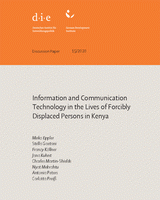Information and communication technology in the lives of forcibly displaced persons in Kenya
Eppler, Mirko / Stella Gaetani / Francy Köllner / Jana Kuhnt / Charles Martin-Shields / Nyat Mebrahtu / Antonia Peters / Carlotta PreißDiscussion Paper 15/2020
Bonn: German Development Institute / Deutsches Institut für Entwicklungspolitik (DIE)
ISBN: 978-3-96021-126-6
DOI: https://doi.org/10.23661/dp15.2020
Preis: 6 €
This report examines how forcibly displaced persons use information and communication technologies (ICTs) in Kenya. Focusing on the role and potential of ICT with regard to mobility and inclusion, this paper studies the needs of forcibly displaced persons and seeks to understand how technology could help to meet these needs. The study identifies success factors concerning the deployment of ICT services, which potentially support the lives of forcibly displaced persons. Based on this analysis, we formulate policy recommendations for organisations who want to deploy ICT services for forcibly displaced persons in Kenya. Since living conditions and access to technology differ in urban, rural and camp environments, the research was conducted in Nairobi, the Tana Delta County and Kakuma Refugee Camp. Our results are based on data collected through a mixed-method approach. Qualitative, semi-structured interviews were conducted with 90 forcibly displaced persons in Nairobi, Kakuma Refugee Camp and the Tana Delta County. Twenty-four organisations providing ICT services in Kenya were interviewed to provide a practitioners’ perspective. The creation of the interview guides and the codebook for the analysis were developed based on the e-governance framework developed by Verdegem and Verleye, who have identified important conditions for a successful uptake of ICT services, namely awareness, perception, access and usability.
Primary policy and practice recommendations include:
- Organisations should avoid doing with ICTs what is already efficiently done in-person. For example, in Kakuma people just walk to the clinics, and are happy to do so. There is not a need for a digital health information solution in this instance – this frees up organizations to focus on using ICTs to solve problems that cannot be effectively solved in-person. These findings indicate critically thinking about ‘digital by default’ strategies.
- For things like health information and education, organizations can take advantage of existing networks that communities have established on platforms like WhatsApp and Facebook. The main advantage that NGOs and refugee organizations can bring in this case is helping make sure information is valid, and helping community organizations prevent rumours from spreading. Indeed, a major risk with health information in particular is that anyone can say anything on a social network, so helping communities validate information is critical.
- We learned through the interviews that refugees’ awareness of different organizations’ online tools was limited. Generating a user base starts with awareness-raising strategies, which appear to be successful through personal contacts. Going directly to a village or to a certain community, and to work with community-based organisations and community leaders as ambassadors, appear to be the best option to reach out to the respective target group.



